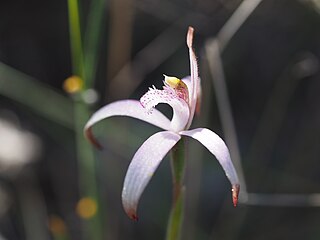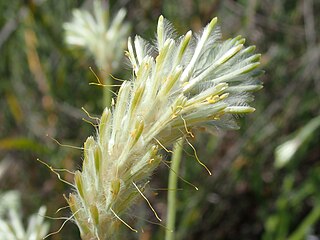
Ptilotus is a genus of approximately 125 species of flowering plants in the family Amaranthaceae, and is endemic to Australia, apart from Ptilotus conicus that also occurs in Malesia. Plants in the genus Ptilotus are annual or perennial herbs or shrubs with usually hairy spikes of compact spherical, oval or cylindrical flowers.

Verticordia halophila, commonly known as salt-loving featherflower, or salt-loving verticordia, is a flowering plant in the myrtle family, Myrtaceae and is endemic to the south-west of Western Australia. It is an erect, bushy shrub with small, crowded, thick leaves and spikes of red and pink flowers in spring.

Verticordia venusta is a flowering plant in the myrtle family, Myrtaceae and is endemic to the south-west of Western Australia. It is an openly branched shrub with small, egg-shaped leaves and spikes of pink to maroon-coloured flowers in spring and early summer.

Praecoxanthus aphyllus, commonly known as leafless orchid, is the only species of the flowering plant genus Praecoxanthus in the orchid family, Orchidaceae and is endemic to the south-west of Western Australia. Plants in flower lack a true leaf, although those plants that are not flowering do possess a green leaf. This species is one of the first orchids to flower each year and its creamy white, fragrant flower easily distinguishes it from other species.
Persoonia manotricha is a species of flowering plant in the family Proteaceae and is endemic to Western Australia. It is an erect shrub with hairy young branchlets, more or less cylindrical leaves and greenish yellow flowers in groups of up two to eight on a rachis 2–15 mm (0.079–0.591 in) long. It is similar to P. bowgada and P. hexagona but has longer pedicels than P. bowgada and differently grooved leaves from P. hexagona.

Caladenia hirta subsp. rosea, commonly known as the pink candy orchid or candy orchid, is a plant in the orchid family Orchidaceae and is endemic to the south-west of Western Australia. It is a widespread and common orchid which has a single leaf, up to three pale pink to deep pink flowers and often grows in clumps.

Caladenia longicauda subsp. merrittii, commonly known as Merritt's white spider orchid, is a plant in the orchid family Orchidaceae and is endemic to the south-west of Western Australia. It has a single hairy leaf and up to three large, mainly white flowers with very long, drooping lateral sepals and petals, and a white broad labellum with relatively short labellum teeth. It is one of the largest spider orchids.
Caladenia reptans subsp. impensa, commonly known as the pale pink fairy, is a plant in the orchid family Orchidaceae and is endemic to the south-west of Western Australia. It has a single hairy leaf and up to three pale pink flowers which have a labellum with three distinct lobes. It is similar to subspecies reptans except that its leaf is green on both sides and the flowers are larger and on a taller flowering spike.

Caladenia saxicola, commonly known as the banded ironstone spider orchid, is a species of plant in the orchid family Orchidaceae and is endemic to the south-west of Western Australia. It has a single erect, hairy leaf and one or two dull creamy-white to pale yellow flowers with spreading lateral sepals and petals.

Ptilotus polystachyus is a perennial herb in the Amaranthaceae family.

Ptilotus latifolius, the tangled mulla mulla, is a perennial herb that is native to Australia, which grows abundantly on sand dunes and stony plains. The key diagnostic features of this plant are its very stem bound, shrub like appearance with densely clustered white white flowers with pink tips when newly blossomed. Each stem is generally supported by one to two leaves and the stems have a fluffy textures as well as the flowers. The petiole is generally long in this species and spike bound.
Cryptandra exserta is a flowering plant in the family Rhamnaceae and is endemic to inland Western Australia. It is a shrub with narrowly oblong leaves and clusters of white, tube-shaped flowers.

Babiana grandiflora is a perennial plant of 8–14 cm (3.1–5.5 in) high that emerges at the start of every growing season from an underground corm. It has pleated sideways flattened leaves. It can be distinguished from other species of bobbejaantjie mainly by its very large, mirror-symmetric deep to pale bluish flowers near the ground. It also has very short filaments crowded near the dorsal tepal, resulting in the anthers being largely hidden within the floral cup of the funnel-shaped perianth. The perianth is entirely filled by the style in the bottom half of the tube. The flowers have a strong acrid-spicy, violet-like scent. Babiana grandiflora is native to the coastal plains of Namaqualand, South Africa. The continued survival of this species is considered being of least-concern.
Ptilotus actinocladus is a species of flowering plant in the family Amaranthaceae and is endemic to inland Western Australia. It is a prostrate annual herb with a central stem and radiating lateral stems, linear to lance-shaped stem leaves, pink spherical or cylindrical spikes of flowers with long, silky hairs, and four fertile stamens.

Ptilotus aervoides, commonly known as mat mulla mulla, is a species of flowering plant in the family Amaranthaceae and is endemic to western Australia. It is a prostrate, mat-forming annual or short-lived perennial herb, its stems densely hairy at first, egg-shaped to spatula-shaped stem leaves, dense spikes of hairy creamy-green flowers with two or three fertile stamens.

Ptilotus albidus is a species of flowering plant in the family Amaranthaceae and is endemic to inland Western Australia. It is a compact perennial shrub with linear leaves, spherical spikes of white flowers and dull brown seeds.
Ptilotus alexandri is a species of flowering plant in the family Amaranthaceae and is endemic to the far west of Western Australia. It is an erect, annual herb with spatula-shaped leaves, spikes of pink flowers and glossy black seeds.
Ptilotus andersonii is a species of flowering plant in the family Amaranthaceae and is endemic to a restricted area of Western Australia. It is a prostrate, hairy, perennial herb with a spatula-shaped to lance-shaped leaves at the base of the plant, lance-shaped cauline leaves, and pink, oval spikes of flowers with two fertile stamens.
Ptilotus angustifolius, commonly known as regal fox tails, is a species of flowering plant in the family Amaranthaceae and is endemic to South Australia. It is a low, bushy herb with a several stems, narrowly egg-shaped leaves at the base of the plant, oval, intensely fragrant spikes of purple flowers and cylindrical heads of many long, hairy fruits.

Ptilotus appendiculatus is a species of flowering plant in the family Amaranthaceae and is endemic to the north of Western Australia. It is a prostrate perennial herb with egg-shaped leaves and spikes of pink flowers.













